
Cladonia rangiferina, also known as reindeer cup lichen, reindeer lichen or grey reindeer lichen, is a light-colored fruticose, cup lichen species in the family Cladoniaceae. It grows in both hot and cold climates in well-drained, open environments. Found primarily in areas of alpine tundra, it is extremely cold-hardy.

Cladonia is a genus of moss-like lichens in the family Cladoniaceae. They are the primary food source for reindeer/caribou. Cladonia species are of economic importance to reindeer-herders, such as the Sami in Scandinavia or the Nenets in Russia. Antibiotic compounds are extracted from some species to create antibiotic cream. The light green species Cladonia stellaris is used in flower decorations.

Cladonia asahinae, the pixie cup lichen or Asahina's cup lichen, is a species of cup lichen in the family Cladoniaceae. C. asahinae occurs in Europe, North America, southern South America, and the Antarctic. It typically grows in high moisture environments in soil rich in humus or on dead wood.

Cladonia fimbriata or the trumpet cup lichen is a species cup lichen belonging to the family Cladoniaceae.

Cladonia cristatella, commonly known as the British soldiers lichen or the British soldiers cup lichen, is a fruticose, cup lichen belonging to the family Cladoniaceae. The species was first described scientifically by American botanist Edward Tuckerman in 1858.
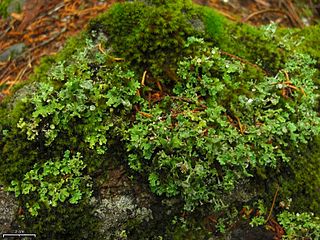
Cladonia macrophyllodes, commonly known as the large-leaved cladonia or the large-leaved cup lichen, is a species of cup lichen in the family Cladoniaceae.

Cladonia stellaris or the star-tipped cup lichen is an ecologically important species of cup lichen that forms continuous mats over large areas of the ground in boreal and arctic regions around the circumpolar north. The species is a preferred food source of reindeer and caribou during the winter months, and it has an important role in regulating nutrient cycling and soil microbiological communities. Like many other lichens, Cladonia stellaris is used by humans directly for its chemical properties, as many of the secondary metabolites are antimicrobial, but it also has the unique distinction of being harvested and sold as 'fake trees' for model train displays. It is also used as a sound absorber in interior design. The fungal portion of Cladonia stellaris, known as a mycobiont, protects the lichen from lichenivores, superfluous solar radiation, and other kinds of stressors in their ecosystem.

Cladonia parasitica, commonly known as the fence-rail cladonia, fence-rail cup lichen or parasite club lichen, is a species of fruticose, cup lichen in the family Cladoniaceae. It was first described by Hoffmann in 1784 under the name Lichen parasiticus, until he reclassified it under the genus Cladonia in 1795.
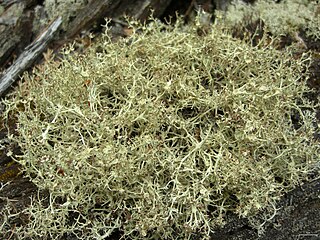
Cladonia amaurocraea, commonly known as the quill lichen or the quill cup lichen, is a species of fruticose, cup lichen in the Cladoniaceae family.

Cladonia arbuscula, also referred to as shrubby cup lichen or green reindeer lichen, is a species of cup lichen in the family Cladoniaceae.
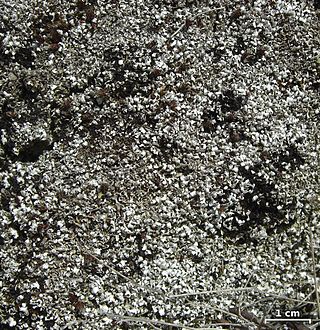
Cladonia cariosa, the split-peg lichen or the split-peg soldiers cup lichen, is a species of fruticose, cup lichen in the family Cladoniaceae. It was first formally named by Erik Acharius in 1799 as Lichen cariosus and transferred to the genus Cladonia in 1827 by Kurt Polycarp Joachim Sprengel. It has a broad distribution, occurring in Europe, Asia, North America, and South America.

Cladonia deformis, also known as the lesser sulphur cup or the lesser sulphur cup lichen, is a light-coloured, fruticose, cup lichen belonging to the family Cladoniaceae. This lichen was first described as Lichen deformis by Carl Linnaeus in 1753, and transferred to the genus Cladonia in 1796 by Georg Franz Hoffmann.

Cladonia digitata, commonly known as the finger cup lichen, is a cup lichen species in the family Cladoniaceae.

Cladonia coccifera or madame's cup lichen is a species of fruticose, cup lichen in the family Cladoniaceae. It was first described by Swedish lichenologist Carl Linnaeus in his 1753 work Species Plantarum. German botanist Carl Ludwig Willdenow transferred it to the genus Cladonia in 1787. The lichen has apothecia and bright red pycnidia atop of yellowish to grey-green podetia that are 1–2 cm (0.4–0.8 in) high. The base of the thallus comprises rounded squamules (scales) with a yellow to orange-brown undersurface. It typically occurs on acidic peaty and sandy soils.

Cladonia cornuta or the bighorn cup lichen is a species of fruticose, cup lichen in the family Cladoniaceae. It was first described as a new species by Swedish lichenologist Carl Linnaeus in his seminal 1753 work Species Plantarum. German biologist Georg Franz Hoffmann transferred it to the genus Cladonia in 1791. The lichen has a distribution that is circumpolar, boreal, and arctic. It has also been recorded from the Southern Hemisphere.
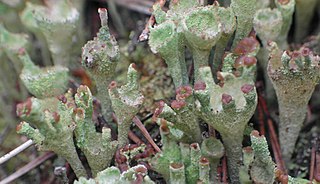
Cladonia pyxidata or the pebbled cup lichen is a species of cup lichen in the family Cladoniaceae. It is host to the lichenicolous fungus Lichenoconium pyxidatae.
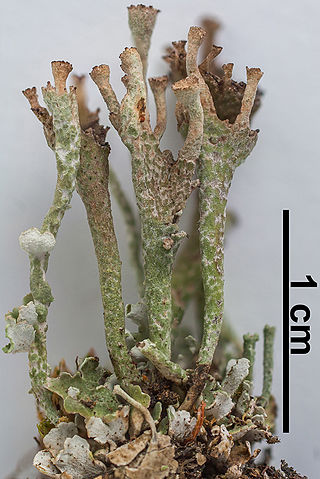
Cladonia cervicornis is a species of cup lichen in the family Cladoniaceae. It was first described by Swedish lichenologist Erik Acharius in 1799 as Lichen cervicornis. Julius von Flotow transferred it to the genus Cladonia in 1849. In North America, it is colloquially known as the ladder lichen or elk's-horn cup lichen.
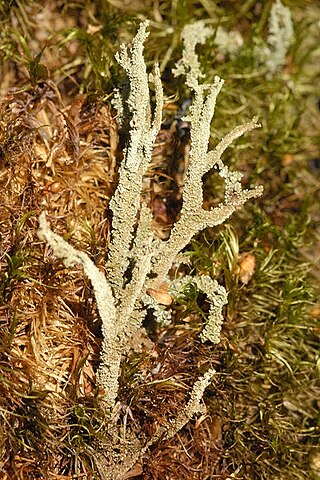
Cladonia squamosa or the dragon cup lichen is a species of cup lichen in the family Cladoniaceae.

Cladonia macilenta or the lipstick cup lichen is a species of cup lichen in the family Cladoniaceae.

Cladonia rei, commonly known as the wand lichen, is a species of ground-dwelling, fruticose lichen in the family Cladoniaceae. It is a widely distributed species, having been reported from Africa, Asia, Australasia, Europe, and North America. It is identified by its slightly dirty-colored, rough-surfaced, slender podetia that grow up to 9 cm (3.5 in) tall. Diagnostic characters of the lichen include the continuously sorediate, green-and-brown-mottled, podetia that taper upward to a point, while chemically, it contains homosekikaic and sekikaic acids. Its reduced capacity to bioaccumulate toxic heavy metals from its surroundings, as well as its ability to switch photobiont partners, allows the lichen to colonize and survive highly polluted habitats. There are several other Cladonia species that are somewhat similar in appearance, but can be distinguished either by subtle differences in morphology, or by the secondary chemicals they contain.




















